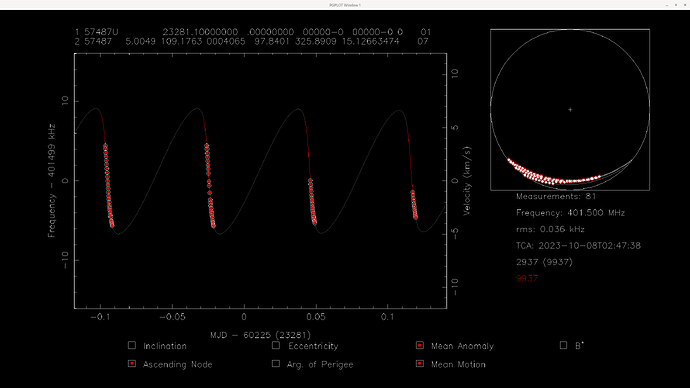This is a known bug, propagate in several cases makes eccentricity and B* parameters 0. In this case before re-fitting the propagated TLE you can copy these values from the old TLE set, fix the checksum, I usually use this tool, and then perform the re-fit.
Got it. Is there a write up somewhere that details TLE generation from observations? I tried looking very hard for complete instructions but could not find any. If not, I would love to write a guide to document this process.
There are some steps here.
However satnogs-waterfall-tabulation-helper.py is unmaintained in purpose, specifically to focus more in the new waterfall data artifact and use this for extracting points for the strf tools. The truth is that is being currently stalled, so we use the old way if there aren’t any strf observations available.
A detailed guide is more than welcome but have in mind that we plan to change this process. About the place that such a guide should live, the answer is the satnogs wiki, however there is an issue and editing isn’t available for now. The best alternative is a thread here in the forum that we can move to the wiki when it is available again.
We managed to generate new TLE for NuLIoN with everyone’s advise:
1 57487U 23109G 23277.01631944 .00000000 00000-0 00000-0 0 08
2 57487 5.0086 140.6248 0000513 78.9138 359.0447 15.12310113 02
With this TLE, we can talk to our satellite ![]()
TLE updated in DB and Network.
Hi Fredy, can i check with you how do you take in measurements from multiple passes for TLE fitting?
Hi, you just merge the contents of the different *.dat files. They contain ascii and can be viewed with a text editor.
Be careful when fitting with data of multiple stations as each station will have a different frequency offset. To get reliable results, you need good data on each station that show a nice Doppler curve. Then fit the tle to each station one by one and take notes of the resulting frequency offset of each station. Then move the points of each station up/down in frequency to sort of calibrate the stations. Next you can use all stations to make the final tle fit.
As @EelkeVisser pointed you can merge the contents of .dat files, a simple cat 1.dat 2.dat > all.dat command works fine.
I second that need to be really careful when you merge data from different stations.
In addition, my tactic that should work fine for this stage of the mission is to select first the more recent points (zoom and select) and fit Ascending Node and Mean Anomaly (2 and 5 options) parameters.
Then you can zoom out (reset view) and select points from older passes and and select to fit Mean Motion (6 option) parameter with the other two already selected.
Two more points:
- Try not to fit too old observations, ideally all observations should be in 24h period.
- Try to fit data from stations that far away each other. I’ve noticed that sometimes fitting using stations in a certain location makes generated TLE biased to that location. For example I’ve generated in past TLE sets that were perfect over Europe but had issues over America or Australia. However this could be affected from the satellite orbit and the parameters that change in each stage of the satellite.
New TLE set for NuLIoN:
NuLIoN
1 57487U 23281.10000000 .00000000 00000-0 00000-0 0 01
2 57487 5.0049 109.1763 0004065 97.8401 325.8909 15.12663474 07
nulion_281.dat (2.8 KB)
sites.txt (3.3 KB)
Hi, thanks all for the guidance. I would like to clarify which DATETIME is used with the propagate tool when fitting multiple observations?
I usually use time near the last observation. However I’m not sure if this is the best way to go. @cgbsat maybe you can give us some feedback on this?
NORAD released a TLE for NuLIoN. However it seems to be quite old and inaccurate based on attempts to contact the satellite with it.
NULION
1 57487U 23109G 23277.66121893 .00038272 00000+0 20399-2 0 9999
2 57487 5.0074 135.6481 0005912 282.3612 77.5834 15.13007122 10049
New TLE set based on space-track.org TLE set and Network observations.
NuLIoN
1 57487U 23287.10000000 .00000000 00000-0 20399-2 0 02
2 57487 5.0049 58.7237 0005912 161.5822 288.4788 15.13914445 07
nulion_287.dat (3.8 KB)
sites.txt (3.3 KB)
One more TLE set used the latest observations for making the previous one more accurate:
NuLIoN
1 57487U 23287.50000000 .00000000 00000-0 20399-2 0 06
2 57487 5.0049 62.0386 0004612 158.1995 310.6410 15.13656783 07
nulion_287_v2.dat (7.0 KB)
sites.txt (3.3 KB)
New TLE for NuLIoN:
NuLIoN
1 57487U 23324.20000000 .00000000 00000-0 68425-3 0 08
2 57487 5.0086 151.6376 0003616 260.7066 1.3325 15.15650321 07
nulion_324.dat (5.1 KB)
sites.txt (4.1 KB)


